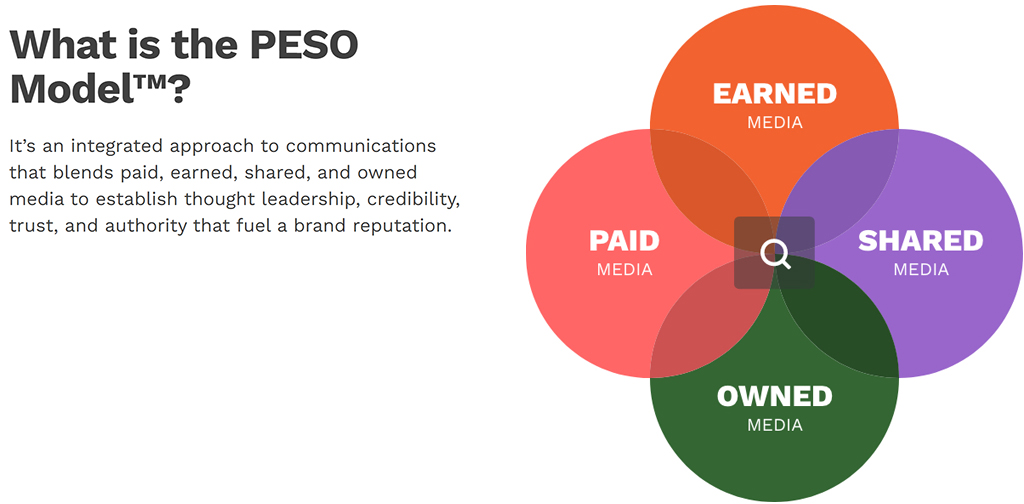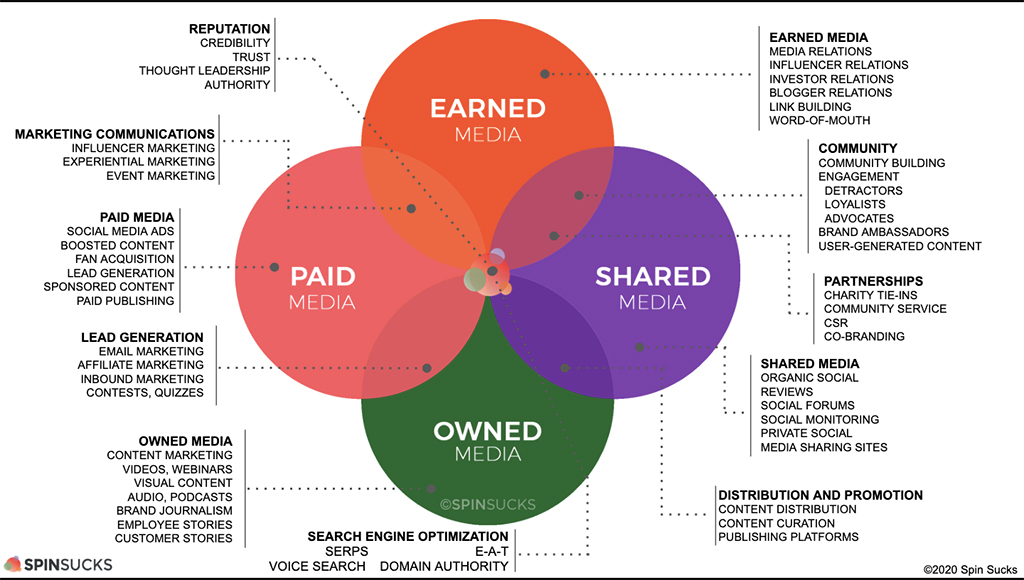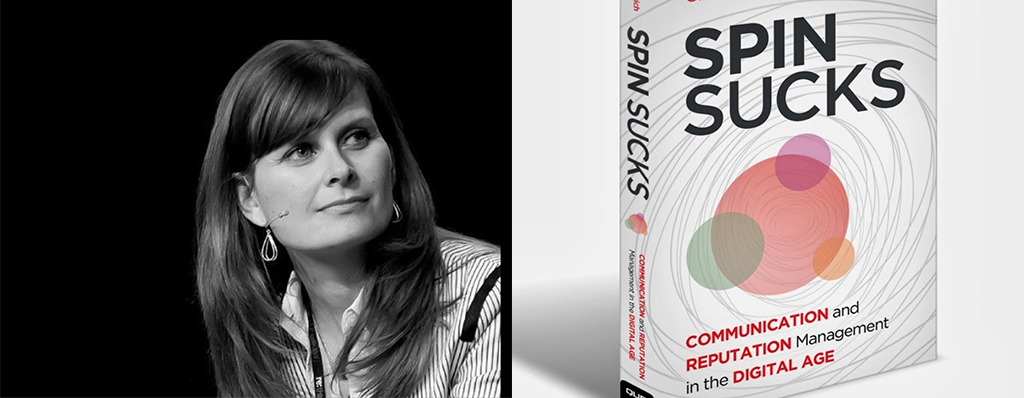By Steve Boehler with special guest Gini Dietrich
Paid. Earned. Shared. Owned.
Today, the idea of a holistic strategy guiding these different approaches is becoming more common by the day. However, it was not always that way. This thinking is less than twenty years old; basically a teenager!
PR pro Gini Dietrich is one of the original thought leaders in this space. Gini is the CEO of PR agency Arment Dietrich and the founder of Spin Sucks. She is the host of the Spin Sucks podcast and author of the book Spin Sucks. She is the creator of the PESO Model™ and has crafted a certification for it in partnership with Syracuse University.
We caught up with Gini to talk about the history and future of paid, earned, shared and owned media planning.
Many marketers and PR pros are familiar with the PESO Model™. For those that aren’t, can you give us a quick overview?
Sure! It’s an integrated communications model that combines paid, earned, shared, and owned media. For so long, communicators have been responsible (mostly) for just the earned segment, but because we are storytellers by nature, it’s important to expand beyond earned to owned and shared, if not paid, as well.
I’ve included paid in there because the model works most effectively when all four media types are working harmoniously. You can certainly do pieces of it, but it won’t be as effective.

In the past fifteen years or so, a number of agencies and marketers have developed models like your PESO Model™. The notion of the importance of, and often interconnected nature of paid-earned-shared-owned communications has become a basic tenet of modern marketing. What can you tell us about your thinking when you first developed your model?
The big reason is that we were having trouble keeping clients happy. They loved paying a retainer to my agency when there were lots of stories published about them, but they didn’t love paying us when we were doing all the background work that comes with getting media placements. So we had a lot of client churn, making running a business incredibly challenging.
I was trying to figure out how to fill the valleys of no media placements with other stuff that generated results for our clients. Social media was becoming a big deal, WordPress had made content management much easier. It was the right place at the right time.
Suddenly we had a model we could execute that filled the valleys of no media placements and gave us a way to measure our efforts directly to sales. Today, I can tell you that if you spend X, we can get you Y—assuming the client allows us to implement the model fully.

The official PESO graphic above is available for free at SpinSucks.com
Marketers, advertising executives, media pros and PR practitioners sometimes look at the world through different lenses. Should a marketer approach the PESO Model™ in a different manner than a PR executive?
This is another “it depends” answer. In B2B, marketers tend to be focused on product or service while communicators are the storytellers and reputation protectors. That shifts slightly in B2C. So how you use it depends on what your role is and how your organization is set up. For some, marketing may be charged with shared and paid media while communicators are charged with earned and owned. The most important thing to do in that case is to work together. If you integrate the four media types, no matter who is in charge, it will be most effective.
What is the best way for any one discipline to approach the PESO Model™?
It depends on your goals. Generally, most will begin with owned media and build a cadre of informative and valuable content. This is because, without content, you have nothing to share on social, nothing to promote in paid, and nothing to show a journalist, blogger, or influencer who you are and what you stand for.
Are there important differences between how a B2C marketer should approach the PESO Model™ as opposed to a B2B marketer?
Yes, of course. I mostly look at it through a B2B lens because that’s the work we do every day, but the work differs from B2C and nonprofits to retail and B2B. The model works for every organization, so adapting it to fit your goals and your audiences is the most important difference.
Everyone is talking about and writing about AI. How will AI change PR, and how will it impact the PESO Model™?
I’m super excited about AI and my January 9 podcast was about all of the things to consider for 2024. It won’t really affect the model itself because it’s a strategic overlay that can evolve with the tools that are available. But I will tell you this: AI is going to make it easier for you to implement the PESO Model. Everything from hyper-personalizing content and posting on social when your audiences are most likely to see it to analyzing data and proving your efforts are instrumental in reaching an organization’s goals.
Looking ahead, what trends do you believe will have the biggest impact on business in the near term, and how would you recommend that marketers and PR pros ready themselves?
It’s all AI right now. Communicators should learn how to prompt AI to get at what makes us most efficient. Learn how to use it. Learn not to be scared of it. Learn how it will provide opportunities for growth. It’s a pretty exciting time to do what we do. Embrace it!
Knowing what you know today, what advice would you give to your 30-year-old self?
Oh, man! I thought I was such a hot shot at 30. Turns out, I barely knew anything. I appreciate that I had as much confidence as I did because it afforded me a business that employs people and takes care of my family, but man. I knew nothing.
I suppose that’s what I would tell myself. If I were to try to start a business today, I don’t think I’d do it. There are too many risks and too many mouths to feed today. At 30, it was just me to worry about. So I would tell myself not to hold back. I’m on the right path.

Gini Dietrich is the CEO or Arment Dietrich and the founder of Spin Sucks. She is the host of the Spin Sucks podcast and author of Spin Sucks (the book). She is the creator of the PESO Model™ and has crafted a certification for it in partnership with Syracuse University. She is also co-author of Marketing in the Round Round and co-host of The Agency Leadership podcast.
Steve Boehler, founder, and partner at Mercer Island Group has led consulting teams on behalf of clients as diverse as Zillow Group, Microsoft, UScellular, Nintendo, Ulta Beauty, Stop & Shop, Qualcomm, Brooks Running, and numerous others. He founded MIG after serving as a division president in a Fortune 100 when he was only 32. Earlier in his career, Steve Boehler cut his teeth with a decade in Brand Management at Procter & Gamble, leading brands like Tide, Pringles, and Jif.
